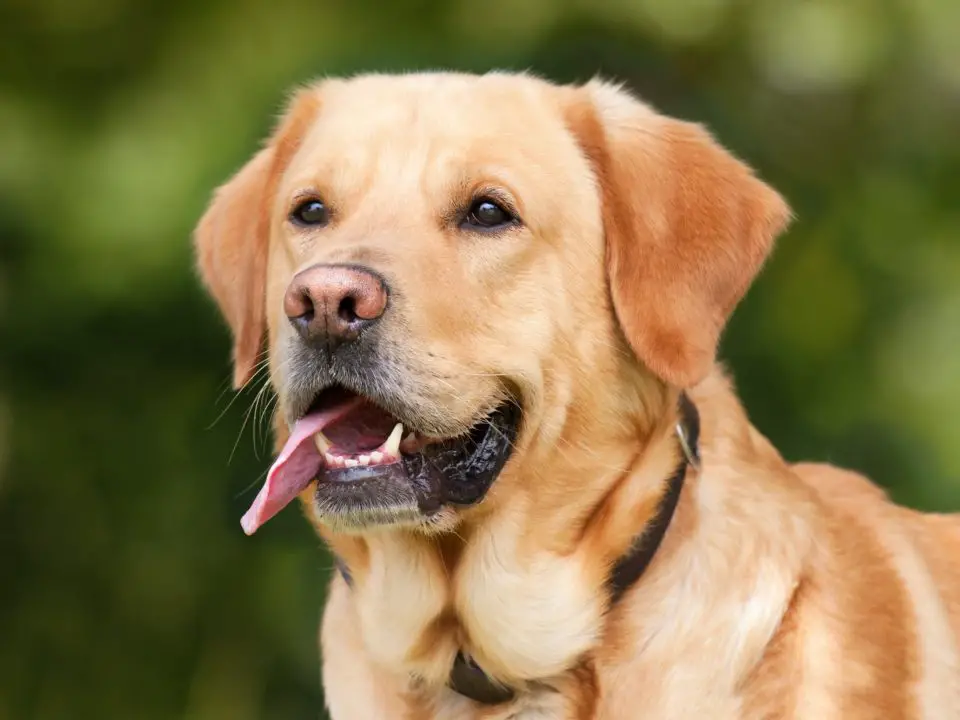Hi, my name’s Valerie and today we’re going to take a look at the best dog brushes for labs!
We all know that our dog needs grooming, but lab owners in particular know this to be more than a requirement, it’s a necessity.
Labs have a wonderful coat, it’s dense, short and also ‘waterproof.’ Lab coats are normally tangle-free, and ears are easy to clean.
The down side of a Labrador coat is that it sheds. Not only does it shed in small amounts, it sheds heaps! And even more in moulting season.
For this reason, a Labrador coat needs to be brushed at least once a week.
From my own experience I know that it is better to start grooming a dog from an early age. That way, they become used to us brushing them.
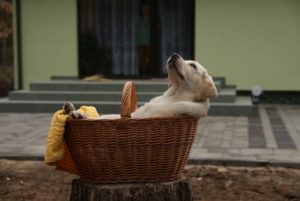
They will soon love the whole experience of being brushed.
One of my friends has a husky and he absolutely LOVES being brushed. He will often sit right next to the grooming box just waiting…
Now, giving your dog a good brush will not only remove mud and debris from the coat, but it will also help to distribute natural oils through his fur and give them that gorgeous, healthy looking shine.
Another very good point in favour of brushing a Labrador is that it will keep the shed hair down in the home.
I know just how annoying it is to have a constant layer of shed hair in the home, visitors arrive clean and leave covered in hair.
Not to mention if people with pet hair allergies arrive. It’s better for all concerned if we get the dead hair down to a minimum so the house stays tidy!
Why do Labs Need brushing?
Brushing our dog’s hair is just a part of his general care routine, although a good brushing will give us a chance to see if anything is out of order.
I’ve picked up on several things like small sores, cuts and lumps, simply by brushing my dog Bentley.
The earlier we can start to brush our dog, the better for him. It gets our pooch used to being handled in a different way, and this is also good in preparation for vet visits, because this is what the vet will do when examining a dog.
Just getting our furry friend used to being rubbed will go a long way to reduce the stress at the vet.
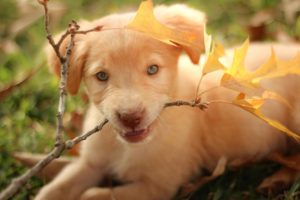
We can start to brush a pup at the tender age of just three weeks, although we should be gentle with the puppy until he is used to being brushed and handled.
It is a good idea to do this, we all know of that poor pup who simply does not enjoy being handled. Brushing your pooch early on will get him used to this.
Brushing regularly can also reduce the need for frequent baths.
While I love my dog beyond words, bathing is a very messy business, so if I can keep his coat clean for longer, I don’t have to clean the bathroom from water which he has sprayed up the walls and mirrors.
Another thing I’ve noticed while brushing my own furry friend is that this seems to strengthen the bond between us.
He knows now that I will never hurt him, and I know that he enjoys our ritual of brushing two – three times a week.
We sit outside in the sunshine and he watches the birds while I talk to him and brush him. Life simply could not get any better!
How Often to Brush/Groom Your Labrador
Well, I have found that this depends on the individual dog. My friend has a short-haired doggie who only needs a brush every other week or so, but a dog with longer hair like my Bentley who is a Doodle, or a Labrador with longer hair needs to be brushed more often.
Brushing also depends on what you and your dog have been doing.
After we have been outdoors my dog always needs a good brush to get rid of sticky bits of grass and plants that he seems to collect.
His feet get muddy in the wet weather and need to be groomed so this routine largely depends on what you and the furry person have been up to.
I think the general opinion on how often to groom dogs is different with each owner. A good idea is to groom ‘as required’. Monitor the condition of your dog’s coat and brush him when he needs it.
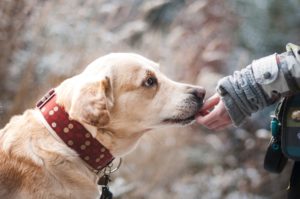 Some labs will shed faster than others, and all will shed in the moulting season. It may be better to groom more often because if left you will end up having to spend hours brushing, whereas regular grooming will cut down a little on time.
Some labs will shed faster than others, and all will shed in the moulting season. It may be better to groom more often because if left you will end up having to spend hours brushing, whereas regular grooming will cut down a little on time.
Leaving a dog too long without grooming him can also have an adverse effect on his health. The matts on the undercoat become tight knots which pull at the skin.
Not only is this painful for a long-haired pooch, but it can cause irritation to the skin.
If the matting has gotten out of control and it simply cannot be brushed out to remove the tangles, you may have to resort to a visit to the vet.
They will most likely shave the dog to remove the matts. This will be unpleasant if you live in a cold climate.
To me it seems that grooming often keeps many problems at bay, and gets our furry friends used to being handled.
I give my dog a good brush at least once a week.
It’s a good time for us to sit comfortably together, and his coat looks lovely afterwards.
What if my Lab Doesn’t Like Being Brushed?
There are some Labs who may not like being handled, maybe you have brought your Lab home from a rescue centre and he is still feeling his way. For whatever reason, your pooch may just not be ready for a brush.
As dog owners we know that we need to get rid of dead hair, but the last thing we want to do is upset our friend, so go for a grooming mitt.
Grooming mitts come to fit on either one hand or both together and they are a good idea as a starter to get your dog used to being handled.
They may also be good for older puppies who shy away from the brush as it will get them used to being handled.
Why There are so Many Types of Brushes?
It can be confusing to decide which brush to buy for your Lab, because there are just so many on the market.
I’ve done some research on this and found that the biggest mistake we can make is to buy a brush that only does the top coat.
 Also, we should choose a brush that suits our particular breed, as some are specifically designed for short hair. These will often not work on our long-haired pooches.
Also, we should choose a brush that suits our particular breed, as some are specifically designed for short hair. These will often not work on our long-haired pooches.
So, we need a brush, or brushes, that take care of the undercoat as well as the top coat.
If the undercoat gets matted, it will hurt and irritate the skin as the matts gets tighter.
Not only will this get smelly when it gets dirty, but you could find skin infections developing.
A Labrador puppy has a different coat to an older Lab, so the brush is going to be different.
It should be softer so that it does not hurt the tender skin.
Different Types of Dog Brushes
There are several types of brush, I’ve narrowed them down to six that should cover everything.
You may find that you don’t need all six of them, and this depends on how dirty and tangled your Lab gets
Slicker Brush
This brush will work fine with any type of fur, so whatever dog you have, and particularly a Lab, this is a good all-round brush.
The brush normally has a flat or curved head with rows of wire pins. It is the pins which remove the tangles and loose fur.
Pin Brush
Normally the pins are covered with plastic or rubber. The brush looks like the Slicker brush but works very well with longer hair.
If your pooch has silky, long fur, then you should keep one of these brushes around.
These brushes are also longer than Bristle brushes. They work best for brushing the top coat and removing loose hair but are not suitable for the undercoat.
Bristle Brush
If you have a dog with a short or wiry coat, then these brushes work very well to remove debris and dirt, leaving the coat shiny.
Different bristle brushes have different spaces between the bristles, so depending on the type of hair your dog has, these will work well.
Short hair needs short bristles, and long hair needs bristles which are wider apart and longer.
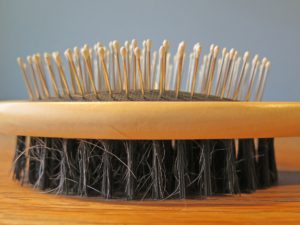 The Shedding Blade
The Shedding Blade
This sounds really scary, but in fact they’re not. The blade is in a horseshoe shape and has small teeth to run over the top of the coat to remove dead and loose hair.
Undercoat Rake
This is one brush which every dog owner who has a long-haired pooch will need.
It gets deep into the undercoat and removes the matts and tangles. You will find that the top coat is left shiny and smooth.
I have found that this type of brush will penetrate a thick coat easily, even using minimal pressure.
One thing to make sure of is that the pin size matches the length of the dog hair. If the rake is too short it won’t reach the base of the tangle, while a longer rake may damage the skin.
Grooming Mitts
If your dog does not like being brushed, or is simply not used to it, then you may want to get a grooming mitt. One way or another, you need to keep his fur in good condition, so this is what you may need.
While they may not reach the undercoat, they will get the top coat taken care off and with constant use your dog will get used to it.
Hopefully then you will be able to invest in a proper brush.
Stripping Combs
These have teeth which do a light cutting as they pull through the hair, so they can trim the undercoat and get rid of dead hair.
One thing you need to be aware of is that these combs are sharp so make sure you keep them away from children and take care when using them.
Five best dog brushes
I’ve done a lot of research for the best brushes for my own long-haired pooch, and while there are literally hundreds on the market, I have found a few that really fit the bill.
On the whole grooming brushes are not that expensive, so buying a really good quality one will not set you back a fortune.
It’s a good idea to keep a selection of those that you use for your dog.
I’ve also found that a second set kept in the car helps a lot when we go out.
I can brush him as soon as we have finished our walk or hike, and he gets into the car reasonably clean! (emphasis on reasonably here)
1. Thunderpaws De-Shedding Tool and Pet Grooming Brush
This brush is recommended by both vets and professional groomers, and you will find that it is built to last. It has a high-quality 4-inch stainless steel comb section and has its own protective cover.
The brush should reduce shedding by up to 95% so that’s a product that is well worth investing in. Also, the brush does not damage the top-coat so the hair stays shiny and healthy.
You can use the brush for all sizes of pets, and even cats, although it does work well on large breeds like Labs.
If you have any problems with your hands, you will like this brush as the handle is ergonomically designed to feel comfortable when you hold it.
The handles are made from non-slip rubber which makes it easier to use.
What is good about this brush is that it comes with a lifetime warranty as well as a 90-day 100% money back guarantee.
In my opinion, any manufacturer who is prepared to say that deserves to be taken seriously.
2. CleanHouse Dog and Cat Hair Brush
This brush is very easy to use. With a click of a button you can extend the bristles and brush your pooch. When you are finished, click the button again and the bristles withdraw, leaving you to wipe away the excess hair.
The brush works on most kinds of hair so will be great for brushing your lab.
You will notice that the coat stays shiny and thick because it de-sheds even the thickest hair. While you are brushing your dog will enjoy a massage.
If you don’t love this brush, you can return it at any time for a full refund, no questions asked.
3. Dogtorkitty Pet Undercoat Rake
This is a wide brush which is great for de-matting hair. It does not irritate the skin and is very gentle on removing tangles.
This looks a little like a miniature rake and you’ll see that the blades are rounded so that there is less chance of hurting skin.
The blades are made of durable stainless steel and there are 27 blades on the extra wide brush.
You will find that your dog is quite at ease with the undercoat rake to remove the dead hair before it finds its way onto your sofa.
Brushing does not irritate their skin, even if you are firm about it.
This is another risk-free item so if you do not love this brush, just send it back and they will refund you completely.
4. K9KONNECTION FUR Deshedding Tool for Dogs & Cats
This rake works for all types of dogs and even rabbits, although it is designed for dogs such as Huskies and Labs.
The pins are double stainless steel and rotate when you use them. You will find that there is less tugging and pulling on hair, and this is due to the double row design.
This brush is also designed to be used with dogs with sensitive skin because it works gently on removing all the excess hair before it lands on your floor.
This is an all-purpose brush which pretty much takes care of all your brushing needs, so you may never need to buy another brush again.
5. Parateck Dog Grooming Glove
If you have a lab who does not like the brush, then this may be just what you are looking for. It’s a glove which works very well at de-shedding. Its designed for dogs with long hair like Retrievers and Labradors.
You can use the grooming glove after the bath or even during bath-time, and you will find that your pooch gets used to you grooming him while you pet him.
The glove can be adjusted by using the Velcro at the wrist, so suits both thin and thicker wrists. You will see that the back of the glove is made of mesh.
This works well to remove any hair from furniture or carpets, so you can keep your home free of any dog hair.
Final Thoughts
There is possibly no one perfect brush, simply because each dog and his hair are different.
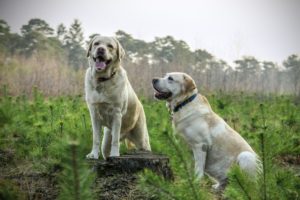 What works for your dog may not work for another.
What works for your dog may not work for another.
What is important is that you find a way to deal with both the under layer and the top layer of your Lab’s coat.
Keeping both layers of the coat in good condition will mean a happier dog, and less chance of irritating skin infections.
Of the brushes I’ve reviewed here, I think you will find one – or a combination – that will suit your Lab perfectly.
Any questions or comments, drop them below!
Thanks:)
